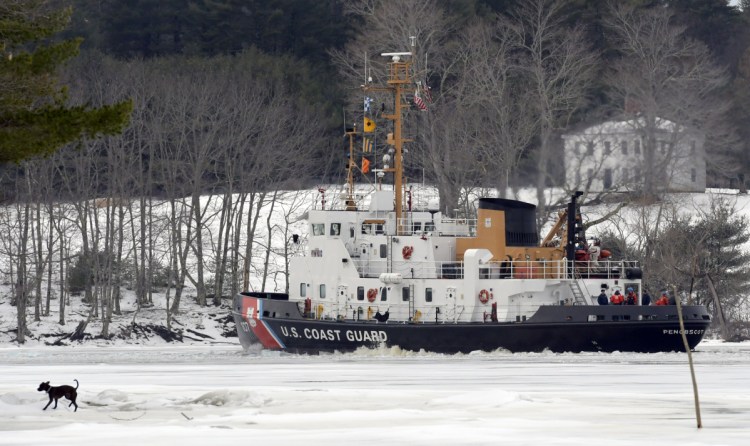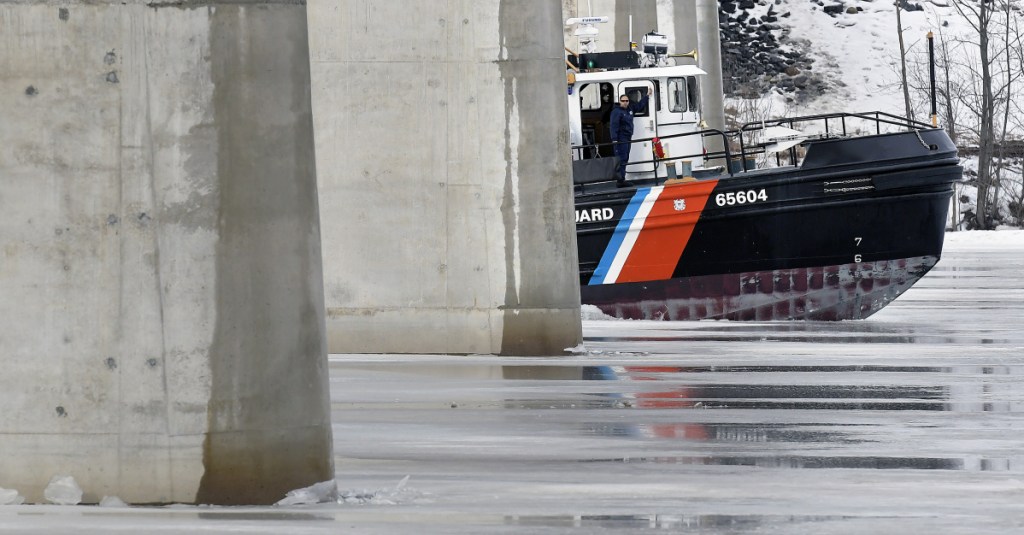RICHMOND — The 140-foot Penobscot Bay smashed, crashed and bubbled its way up the Kennebec River Sunday morning, breaking, at least temporarily, winter’s icy grip while on a mission to help prevent further ice jam-related flooding upriver.
The icebreaker was joined by three smaller, 65-foot cutters, the Bridle, Tackle and Shackle, Sunday to break up Kennebec River ice between the Chops in Woolwich and the Kennebec Bridge that crosses the river between Richmond and Dresden.
The smaller craft split up and broke ice behind the larger Penobscot Bay which, unlike the smaller boats, is equipped with a “bubbler” system. The system uses a low pressure air compressor to push air down through the hull into openings along the keel which help the boat break up the ice.
The larger craft churned through about 12 inch thick ice with relative ease, while the smaller crafts appeared to struggle and make much slower progress.
“They kind of divide and conquer the river,” Coast Guard Lt. Matthew Odom said of the smaller cutters which broke up ice after the Penobscot made the initial break-through. “They stagger themselves along the river” behind the Penobscot Bay and try to keep the ice moving downriver.
The Penobscot Bay and one of the smaller boats that came the farthest upriver were greeted, at the Richmond-Dresden bridge, by a crowd of onlookers on both sides of the river, numbering about 30 people, and at least four dogs, one of which briefly ran out onto the ice, but not near either of the cutters.
“There’s more people here than we had at the last Town Meeting,” joked Dresden resident Peter Walsh, who joined about 20 people on the Dresden side of the river mid-Sunday morning to watch the action out on the river. “That’s quite a sight. It moves right along, doesn’t it?”
The cutters were originally expected to make it to the Richmond-Dresden bridge Saturday, but were delayed by a thick ice dam at Chop Point in Woolwich, where ice chunks had been stacking up on top of other ice, making for a thick dam of ice across the river.
The Penobscot Bay hammered against the ice dam at Chop Point for two days, four hours each day, finally breaking through Saturday. It let out a long blast of its horn when it finally made it through, according to a video posted online on the watercraft’s Facebook page, which closed with someone on board saying “Thanks for watching, everyone, the Chops are open.”
The ice in that dam, according to the Coast Guard, was more than 10-feet-thick in some areas.
Odom said the ice between the Chops and Dresden ranged between 8 and 12 inches thick, with slush on top of it which he said makes breaking up ice more difficult.
The Penobscot Bay churned up to the Richmond-Dresden bridge Sunday morning, sounding its horn as it passed the northern tip of Swan Island. Then it turned around and headed back down river.
The one 65-footer following the Penobscot Bay that far north then continued a bit further north, breaking through the ice under the bridge and going just past the bridge, though much more slowly than the larger craft broke ice. The smaller boat built up speed and powered up onto the ice, breaking the ice with the craft’s weight, until its momentum slowed and it backed up to take another run.
Ice-breaking on the Kennebec generally takes place most springs, but this year the cutters’ help was sought out earlier, to try to clear out ice downriver so, if and when a large ice jam upstream in Farmingdale breaks free, it will have more room to move, and decrease the chances it jams up somewhere else and causes more flooding.
The ice jam was responsible for river flooding in Augusta and Hallowell earlier this month, trapping several cars under the ice and water.
Some parking areas along the river in Augusta and Hallowell remain closed off, due to concerns flooding could return, in part because the ice is still jammed up downriver and could still result in more flooding.
Dresden resident Nancy Cote said she’d lived in the area for some 50 years but, until Sunday, had never seen the ice cutters coming up the river.
Lynda Springer came up from Wiscasset to take photographs of the icebreakers, something she has also done in prior years, though usually much later in the year. She said the ice the boats were breaking up looked thicker than it has in the past. She said she just loves boats, and enjoys taking photographs.
Aasha Edwards, of Bath, also positioned herself in Dresden to watch the icebreakers Sunday morning. She said she’s a native of Iowa, so she had never seen icebreakers in action before.
“It’s just something to do, a Sunday morning adventure,” she said. “I work in Augusta, so I saw all those cars (that were flooded) in Hallowell. It looks like a huge mess. It’s a big jam.”
Odom said the Penobscot Bay won’t go upriver beyond the Richmond-Dresden bridge, due to concerns about the depth of the river. But the smaller cutters will break ice between Richmond and Gardiner this week, though details of those plans hadn’t yet been set by early Sunday afternoon.
“We do plan to continue our efforts in the Kennebec tomorrow, when the tides give us the right window,” Odom said Sunday. “The plan is to make every effort possible, do everything within their power, to make it up to the Gardiner area. That’s entirely contingent on ice conditions.”
The depth of the river and low height of the Pearl Harbor Remembrance Bridge linking Gardiner and Randolph limit the Coast Guard’s ability to reach the ice jam, but it will break ice to open up water downriver to improve the river flow, according to Odom.
Smelt shack operators along the river were warned, ahead of the ice-breaking operations, to remove their shacks from the river, and it appears all did. Fishing continued at some Merrymeeting Bay shack operations in Bowdoinham, in tributaries well away from where the icebreakers did their work.
On the Kennebec River in Pittston, where Bakers’ Smelt Camps ice shacks had all been removed from the ice ahead of the cutters’ arrival, someone had planted a “stop” sign, facing downriver, in the otherwise vacated ice.
The cutters break ice on outgoing tides, so the ice flows out toward the sea after it is broken up. Odom said breaking ice on an incoming tide could lead to ice stacking up after it is broken, which could make ice jams worse.
Keith Edwards — 621-5647
Copy the Story LinkSend questions/comments to the editors.





Success. Please wait for the page to reload. If the page does not reload within 5 seconds, please refresh the page.
Enter your email and password to access comments.
Hi, to comment on stories you must . This profile is in addition to your subscription and website login.
Already have a commenting profile? .
Invalid username/password.
Please check your email to confirm and complete your registration.
Only subscribers are eligible to post comments. Please subscribe or login first for digital access. Here’s why.
Use the form below to reset your password. When you've submitted your account email, we will send an email with a reset code.